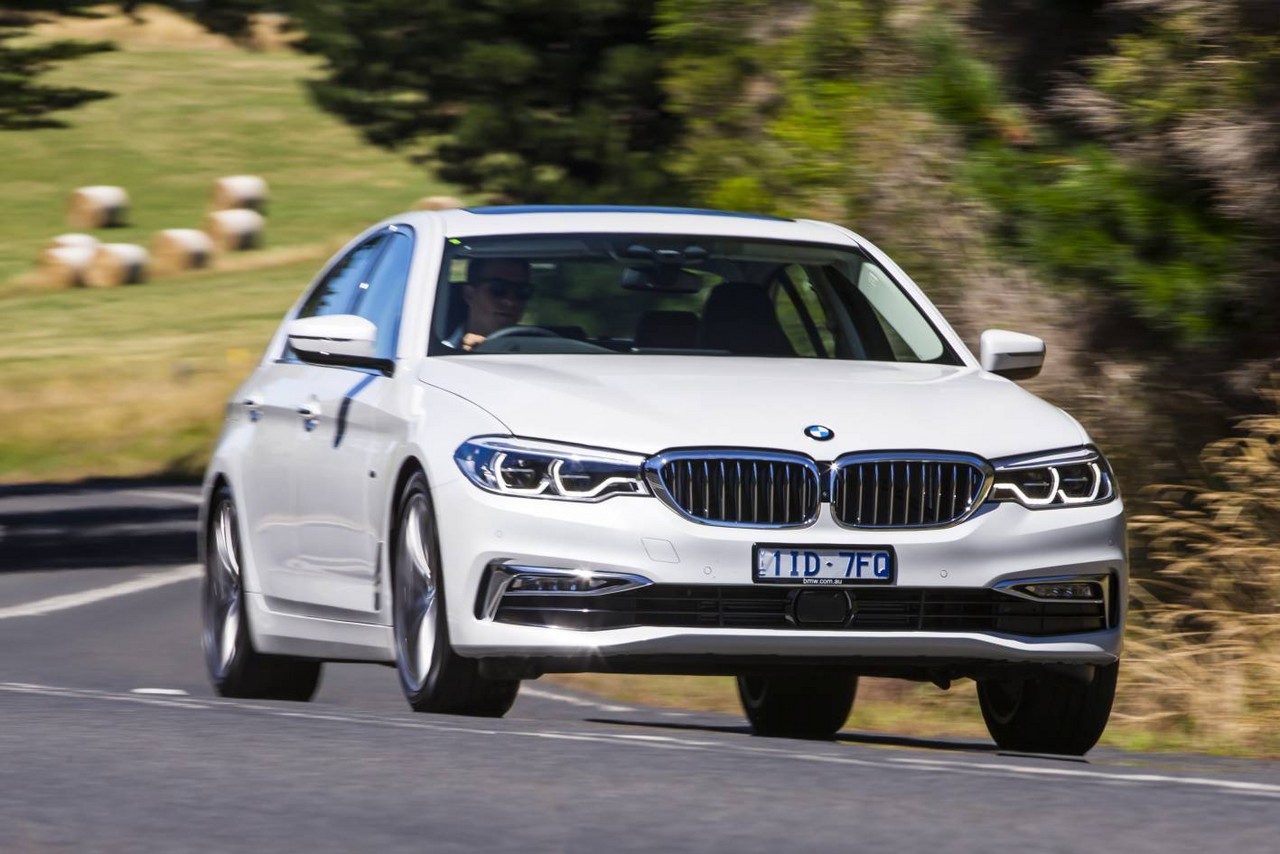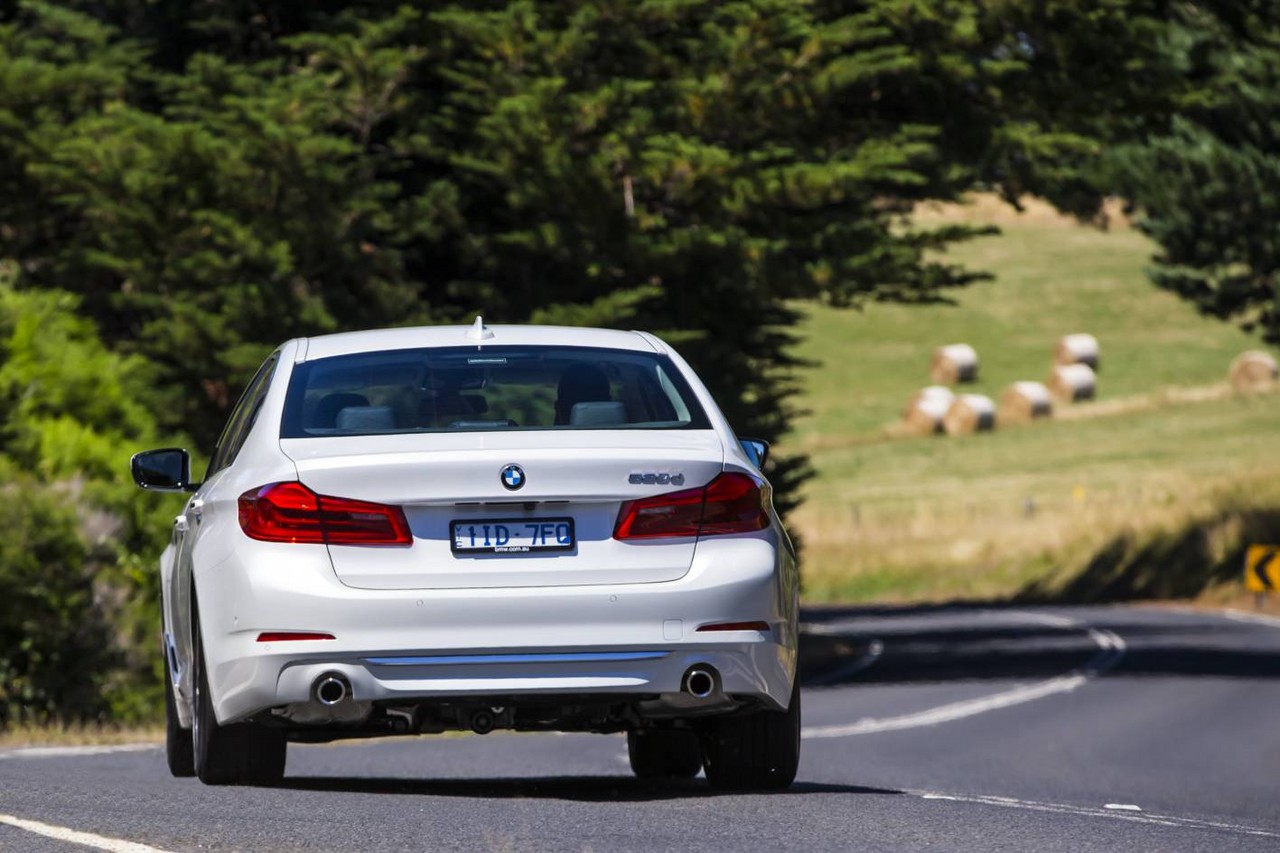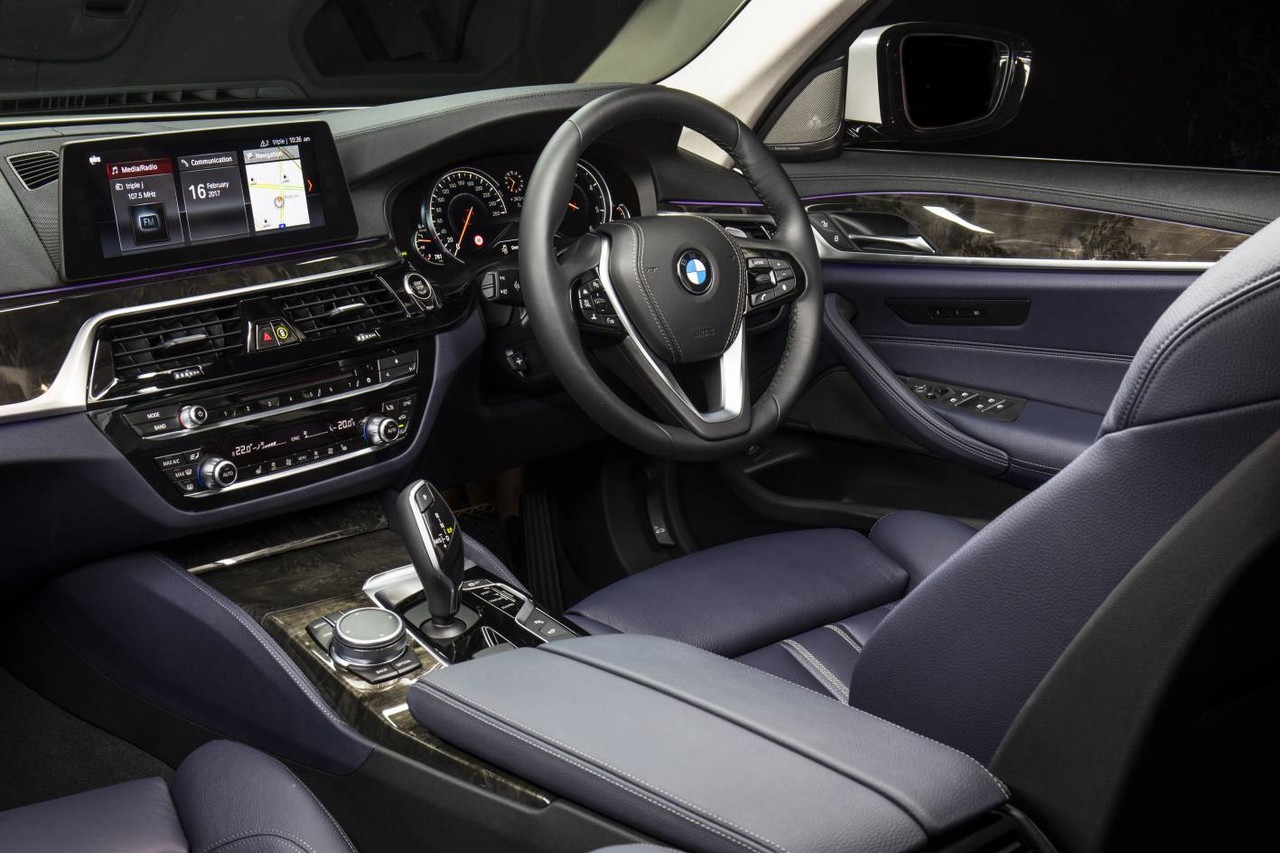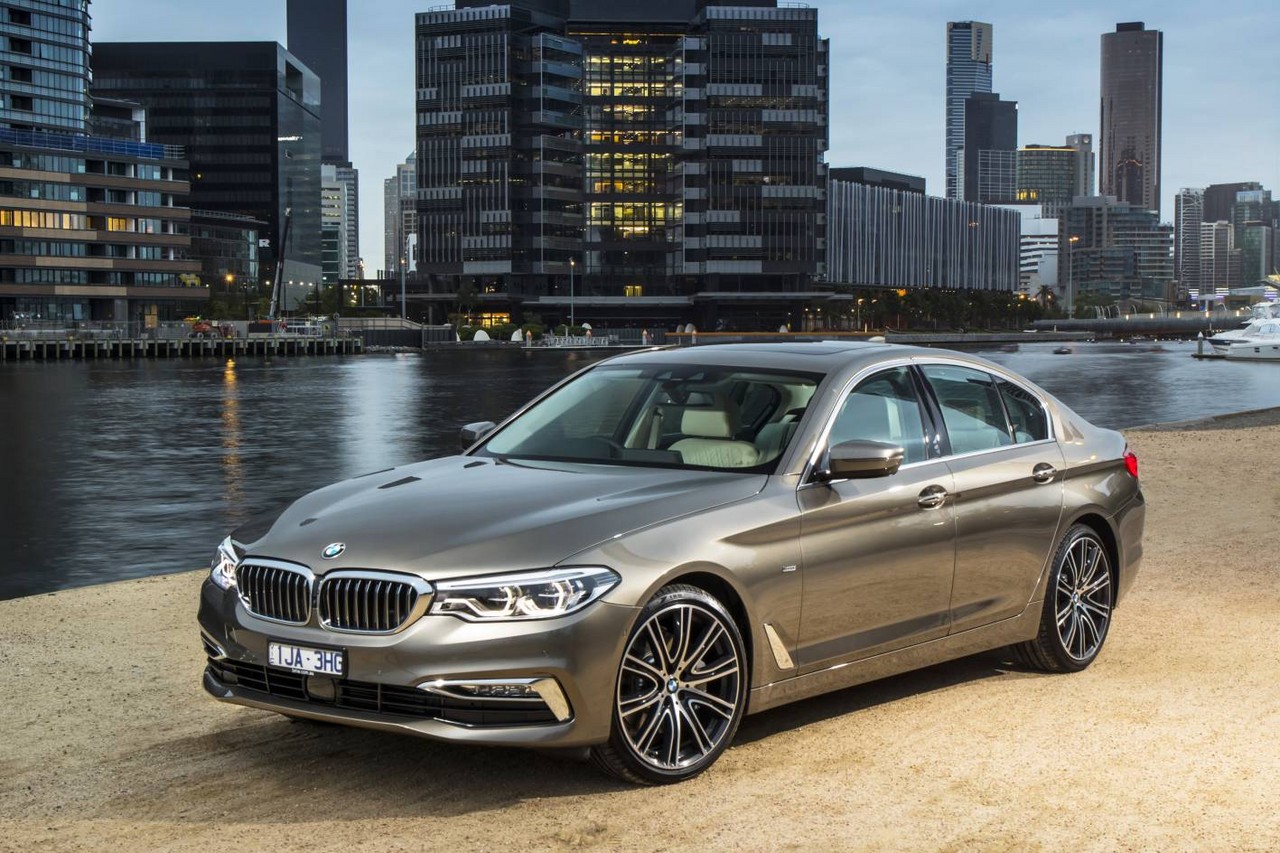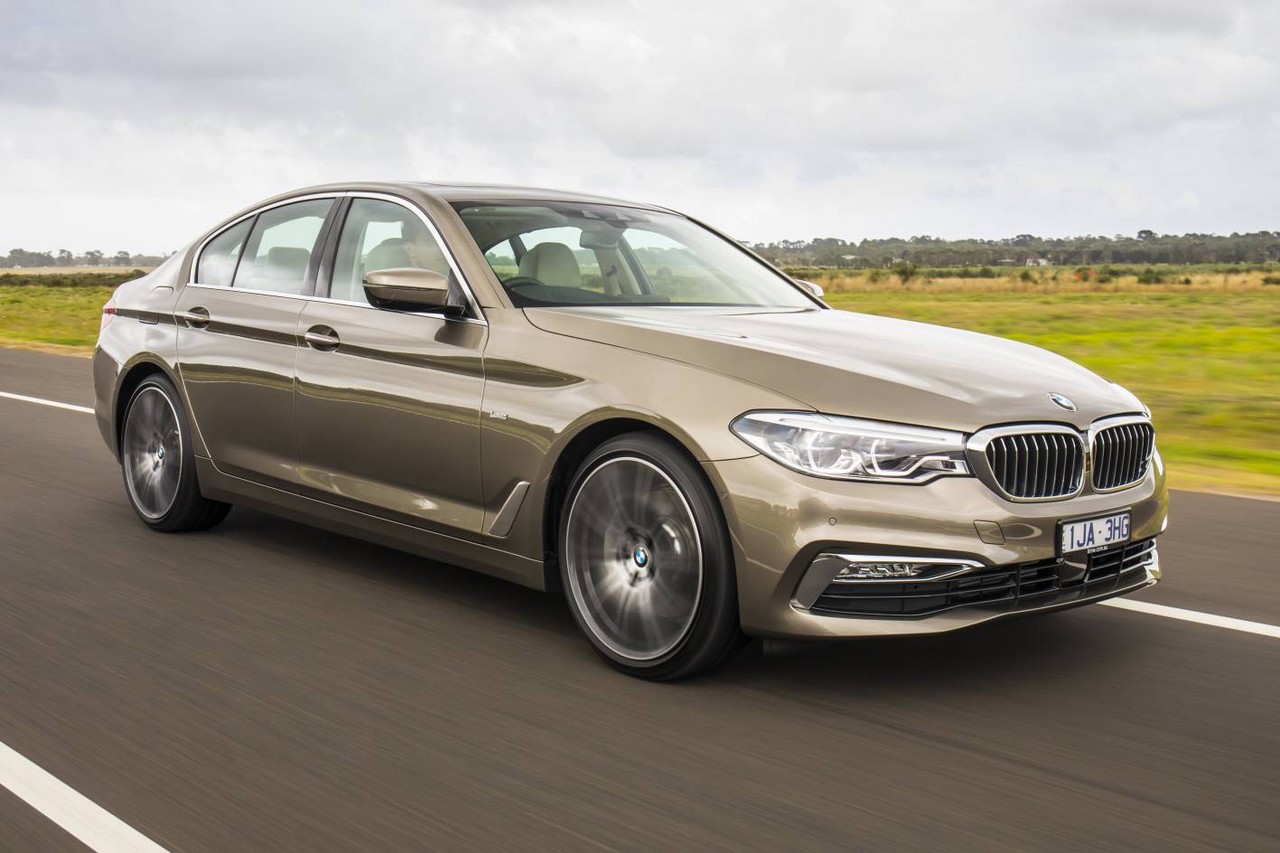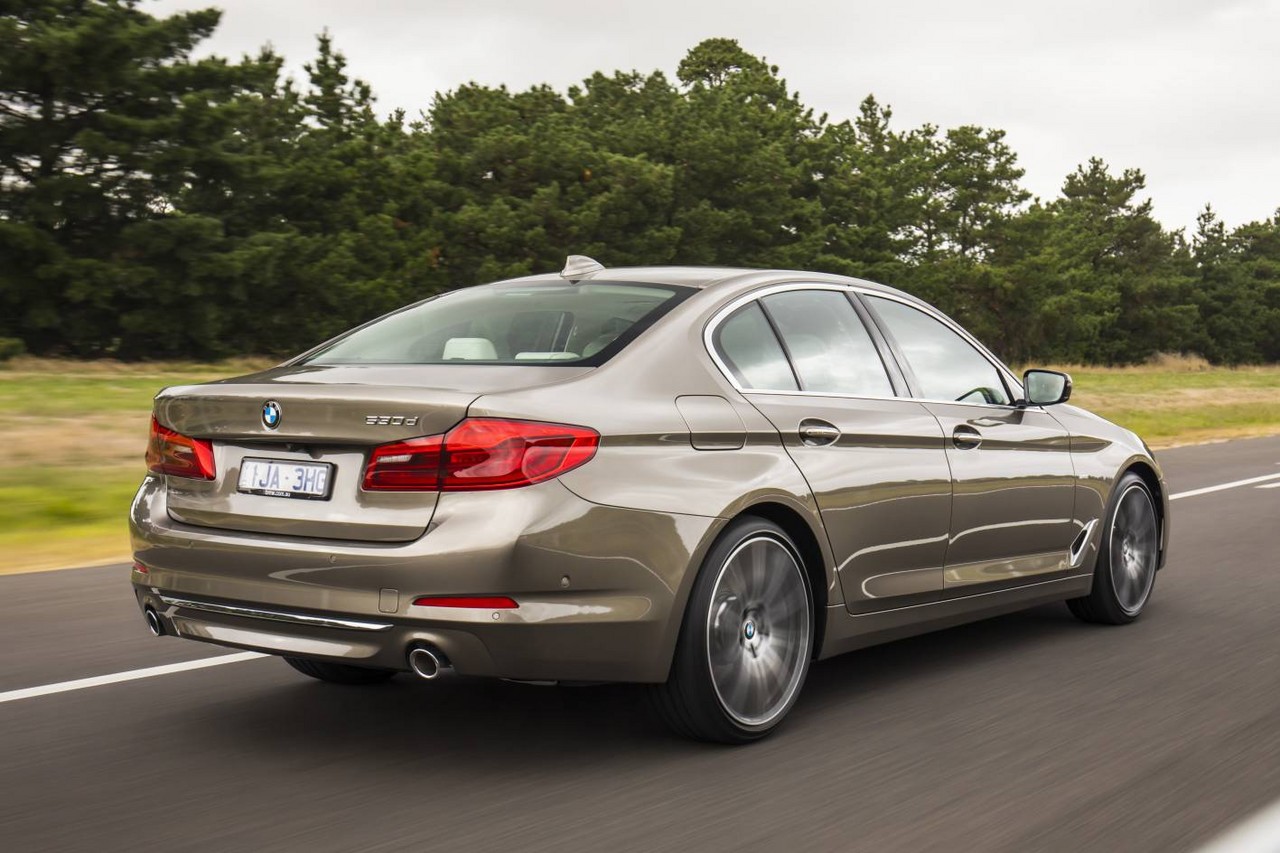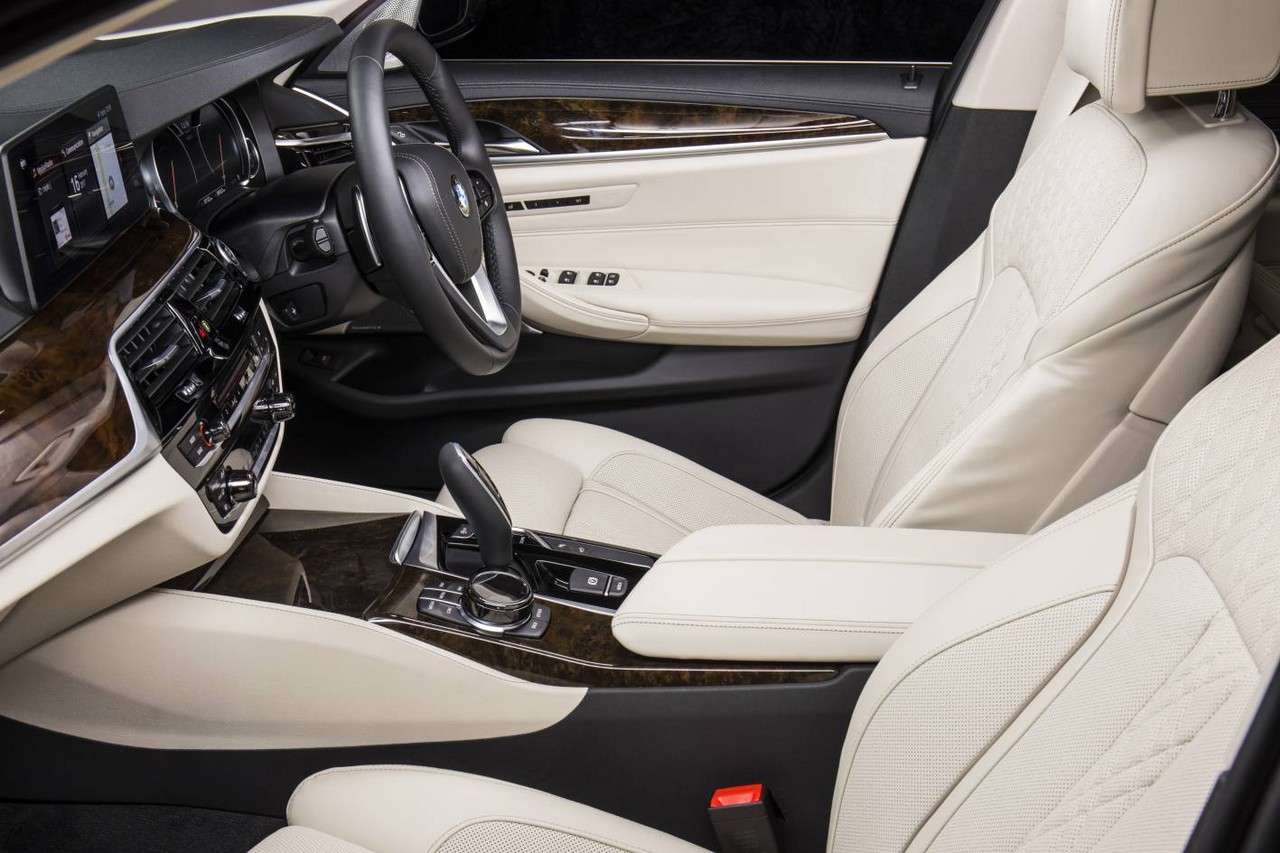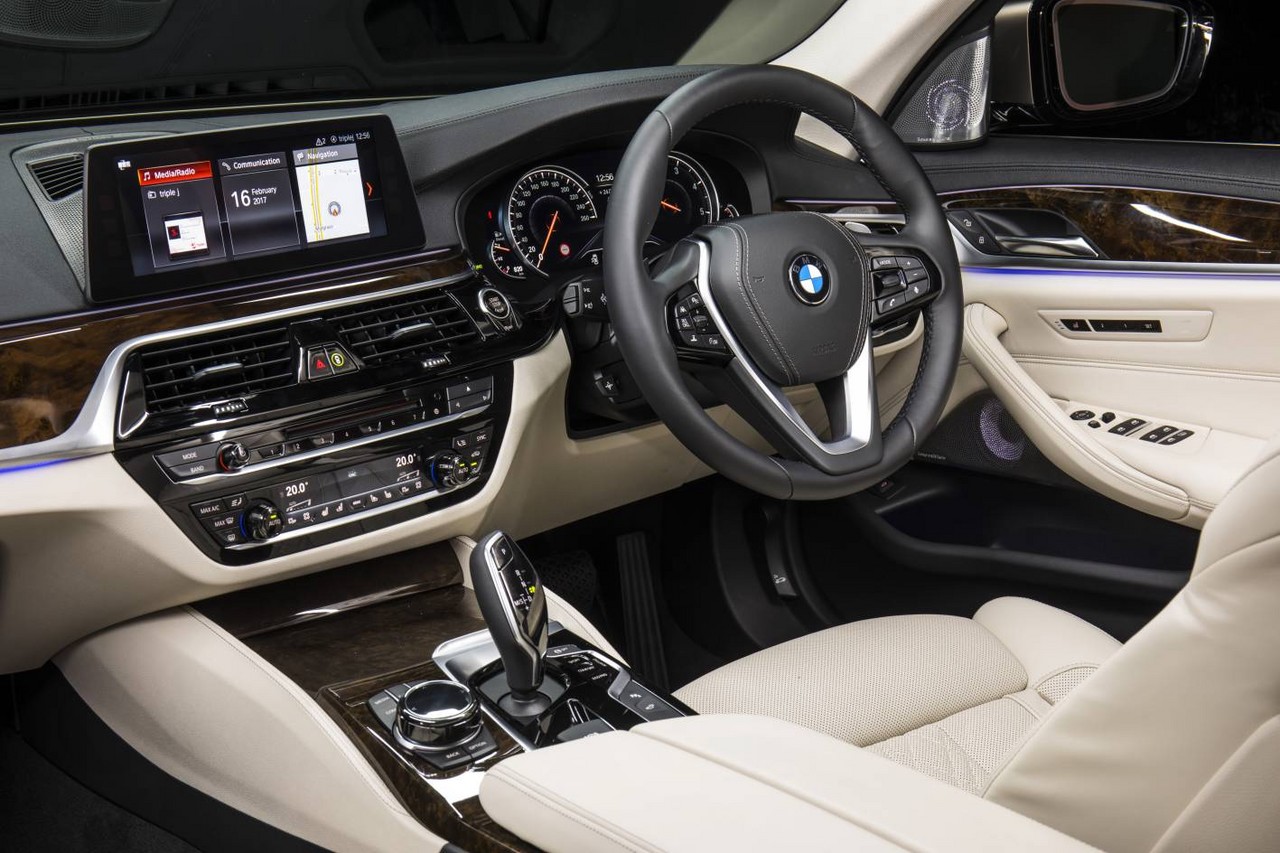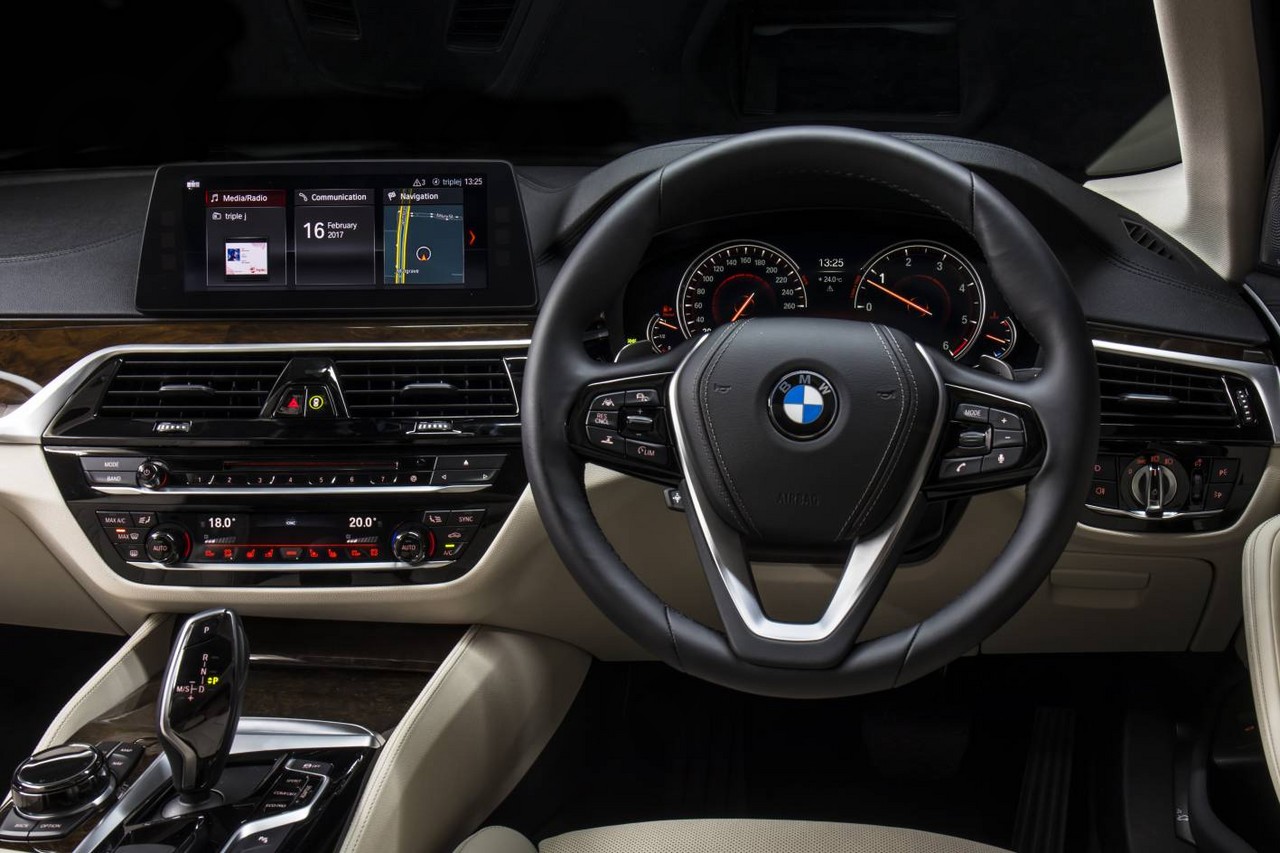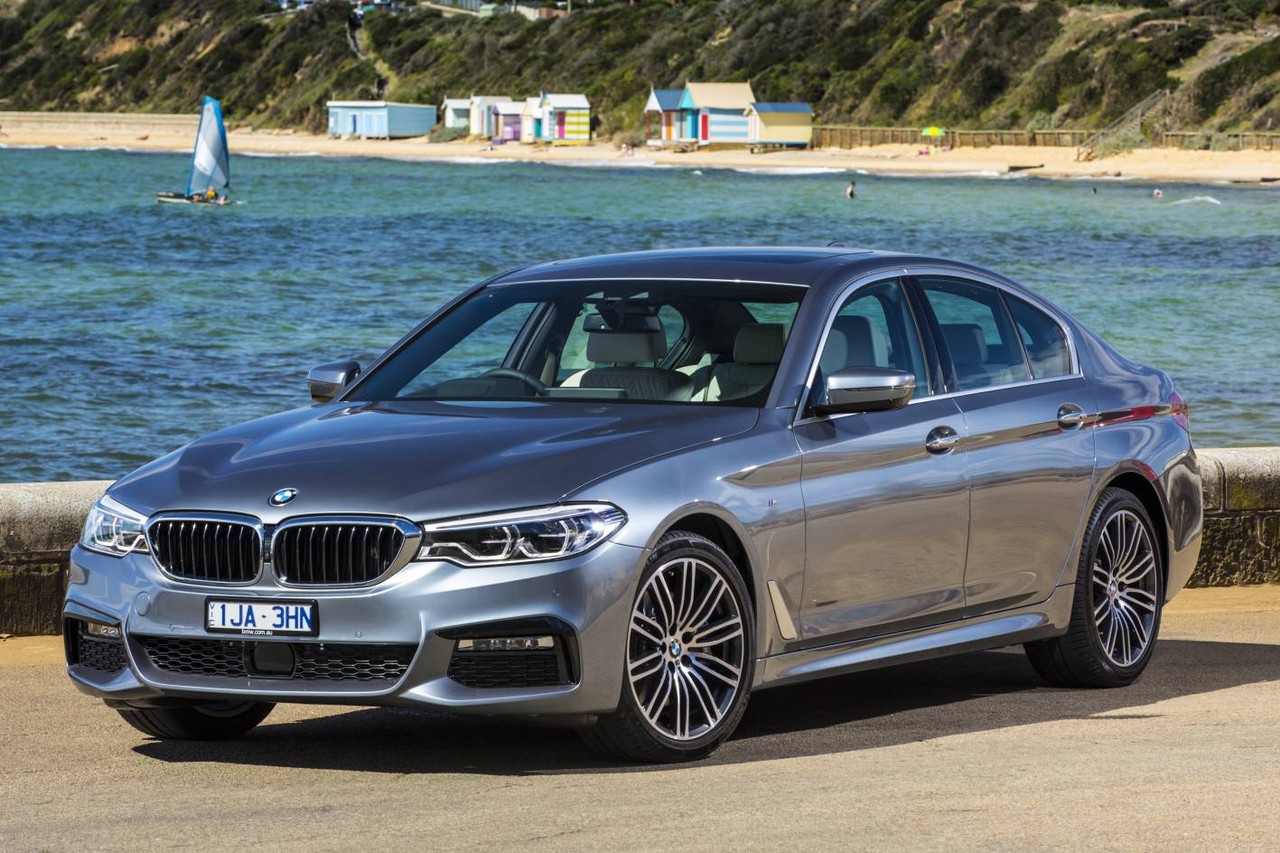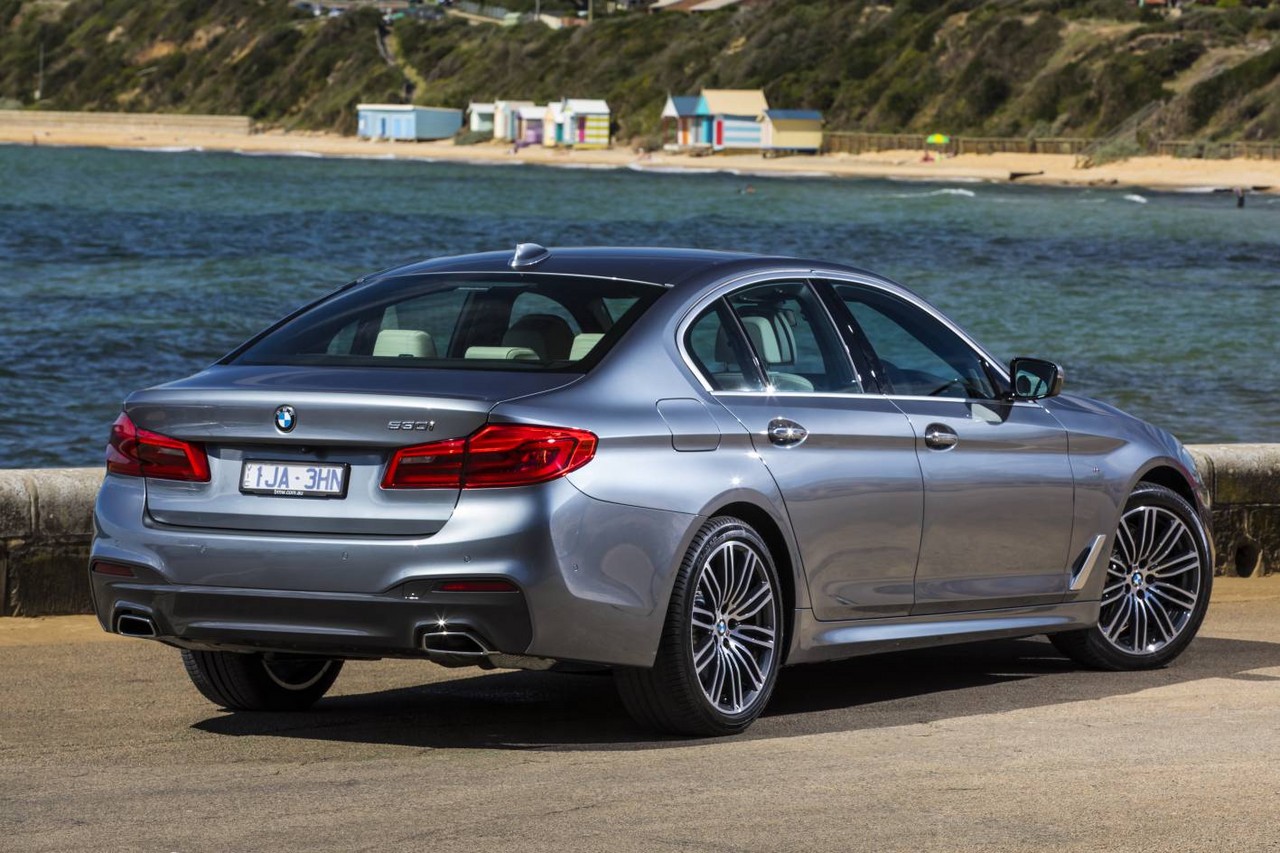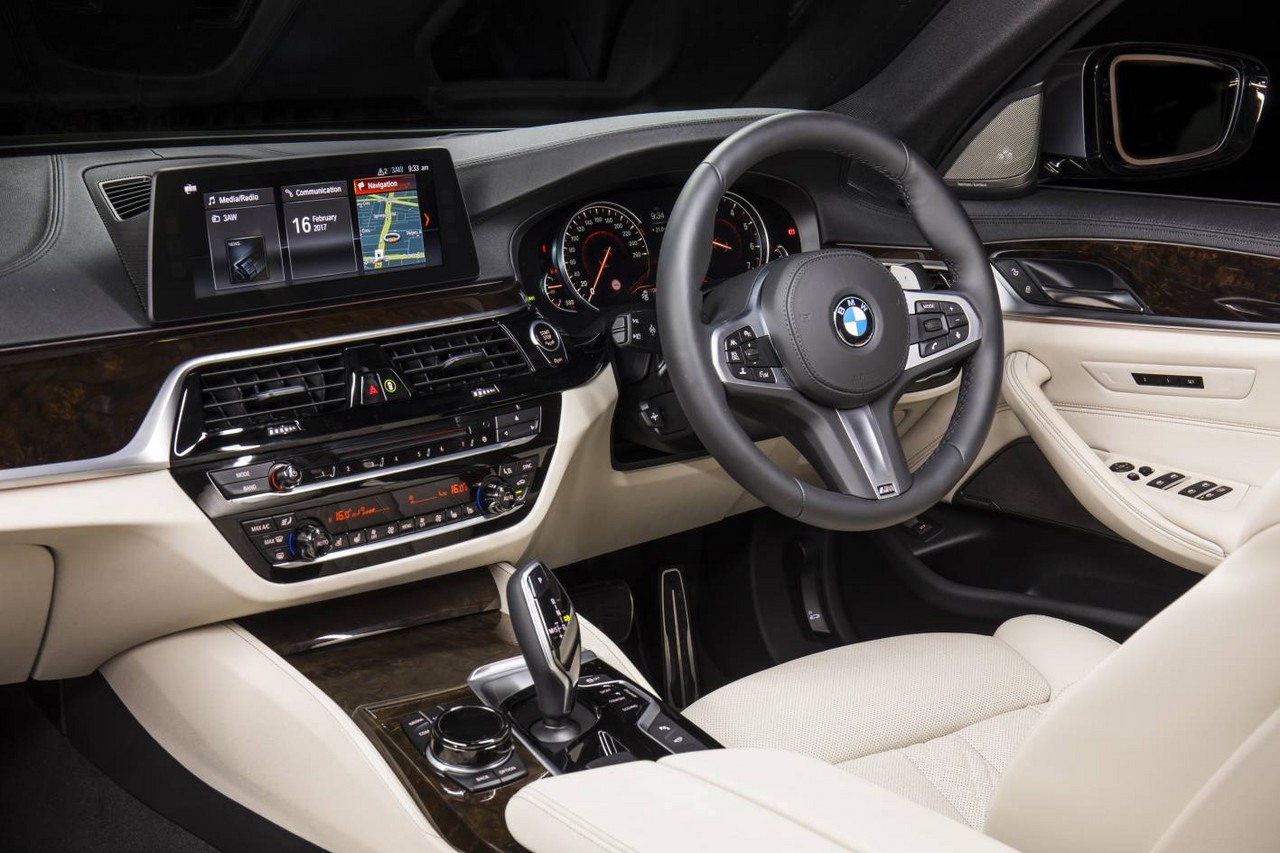
- Impressive ride/handling balance
- Efficient and powerful engines
- Refined eight-speed ZF automatic transmissions
- High standard of interior fit and finish, with 10.25-inch touchscreen
- Interior is spacious and well-insulated
- Narrower seat base for 520d
- Light steering lacks feedback
- Wheel arches reduce boot space
Overview
Released in March 2017, the BMW G30 5-Series was an executive sedan. Manufactured in Dingolfing, Germany, the rear-wheel drive BMW G30 5-Series range for Australia initially consisted of the 520d, 530i, 530d and 540i (see table below). In July 2017, the range was expanded with the introduction of the 520i.
All engines for the BMW G30 5-Series complied with Euro 6 emissions standards and, to reduce fuel consumption, featured:
- Auto Start Stop: could shut down the engine when the vehicle was stationary in traffic to reduce fuel consumption;
- Brake Energy Regeneration: regulated alternator output to recharge the battery when the vehicle was coasting or braking, thereby reducing load when accelerating; and,
- ‘Eco Pro’ drive mode: adjusted engine management and throttle response, and included a coasting function which disengaged the drivetrain to reduce engine braking.
| Engine | Trans. | Peak power | Peak torque | |
|---|---|---|---|---|
| 520i | 2.0-litre B48B20 turbo petrol I4 | 8sp auto | 135 kW at 5000-6500 rpm | 290 Nm at 1350-4250 rpm |
| 520d | 2.0-litre B47D20O0 turbo diesel I4 | 8sp auto | 140 kW at 4000 rpm | 400 Nm at 1750-2500 rpm |
| 530i | 2.0-litre B48B20O0 turbo petrol I4 | 8sp auto | 185 kW at 5200-6500 rpm | 350 Nm at 1450-4800 rpm |
| 530d | 3.0-litre B57D30O0 turbo diesel I6 | 8sp auto | 195 kW at 4000 rpm | 620 Nm at 2000-2500 rpm |
| 540i | 3.0-litre B58M30M0 turbo petrol I6 | 8sp auto | 250 kW at 5500-6500 rpm | 450 Nm at 1380-5200 rpm |
| M550i | 4.4-litre N63B44TU biturbo petrol V8 | 8sp auto | 340 kW at 5500 rpm | 650 Nm at 1800-4500 rpm |
Body and dimensions
Compared to the BMW F10 5-Series Sedan , the G30 5-Series was 37 mm longer (at 4936 mm), 8 mm wider (1868 mm), 15 mm taller (1479 mm) and has a 7 mm longer wheelbase (2975 mm). Furthermore, the G30 520d, 530d and 530i had a drag coefficient of 0.24 Cd. Boot capacity for the G30 5-Series is 530 litres, while the rear backrest could split and fold 40:20:40.
Significantly, the BMW G30 5-Series achieved mass reductions of around 100 kg relative to the F10 5-Series through:
- The increased high-tensile steels in its body;
- The use of aluminium for the bonnet, boot lid, engine cross-member, rear side-members, roof and doors. For example, the doors had aluminium shell construction and weighed around six kilograms each (the lightest of executive sedans);
- Light-metal suspension components; and,
- A cast magnesium instrument panel support that was around two kilograms lighter than the steel version in the F10 5-Series.
Inside, the larger passenger compartment of the BMW G30 5-Series provided greater shoulder and elbow room, rear knee and leg room, while other changes included a lower instrument panel and free-standing display. To reduce interior noise, the G30 5-Series had:
- Synergy Thermoacoustic Capsule (SYNTAK) encapsulation, which consisted of lightweight soundproofing materials surrounding the engine and transmission to reduce interior noise, improve heat retention and thereby reduce fuel consumption;
- Acoustic glazing for the windscreen; and,
- A headliner with integrated soundproofing.
Suspension
The BMW G30 5-Series had double wishbone front suspension with separate upper and lower control arms and an independent, five-link rear axle. As standard, Australian-delivered BMW 530i, 530d and 540i models were fitted with BMW’s ‘Dynamic Damper Control with Dynamic Drive’ which utilised of electronically controlled dampers. Furthermore, the BMW 540i was equipped with BMW’s ‘Adaptive Drive’ which included electrically actuated anti-roll bars.
Steering
The BMW G30 5-Series had rack-and-pinion steering with electric power assistance; the steering had a ratio of 16.3:1 and provided a turning circle of 12.05 metres.
Available as an option, the ‘Integral Active Steering’ system provided rear wheel steering. At parking speeds, the rear wheels would turn in the opposite direction to the front wheels to reduce the turning radius; at higher speeds, the rear wheels would turn in the same direction as the front wheels for greater stability.
Safety equipment
Standard safety equipment for the BMW G30 5-Series included dual front airbags, front seat-mounted side airbags, full-length curtain airbags (i.e. for front and rear occupants), ABS, electronic brake force distribution, brake assist, electronic stability control, traction control, active front seat head restraints and front seatbelts with pre-tensioners and load limiters.
As standard, the G30 5-Series was equipped with BMW’s ‘Driving Assistant’ which included the following technologies –
- Approach control and person warning with city braking function: operating at speeds from 10 km/h to 60 km/h for pedestrian detection and up to 80 km/h for vehicle detection, the approach control warning system would initially warn the driver if there was a risk of a frontal collision. In its second stage, the brakes would be pre-conditioned for faster response and, if the driver failed to react, autonomous emergency braking (AEB) would be initiated to reduce vehicle speed;
- Lane Departure Warning: active at speeds above 72 km/h, the driver would be alerted by steering wheel vibrations if the vehicle deviated from its lane without the prior activation of the indicators;
- Lane Change Warning: active at speeds above 10 km/h, Lane Change Warning would monitor the zones to each side of the vehicle. If the driver activated the indicators to change lanes, the system would check these zones and – if occupied – warn the driver via steering wheel vibrations and flashing a symbol in the respective door mirror;
- Crossing-traffic warning rear: when reversing out of a parking space, ‘Crossing-traffic warning rear’ would warn the driver of approaching traffic that may intersect the driver’s path;
- Prevention of rear collision: if a rear-end collision was anticipated, following traffic would be warned by double frequency flashing of the hazard lights; and,
- Speed Limit Info: incorporated speed restrictions into the driver-selectable Speed Limiter function or Active Cruise Control (where fitted).
Beyond this, BMW’s ‘Driving Assistant Plus’ was also fitted as standard and included the following –
- Active Cruise Control with Stop&Go function: at speeds from 30 km/h to 210 km/h, Active Cruise Control could maintain a speed-dependent distance from the vehicle ahead. With the Stop&Go function, the vehicle could apply the brakes to bring the vehicle to rest and, once the traffic ahead began to accelerate, automatically accelerate if the vehicle had been stationary for a period between 1 and 3 seconds. If the vehicle had been stationary for longer than 3 seconds, the driver would need to briefly press the accelerator or a button to initiate acceleration up to the previously set cruising speed;
- Steering and lane control assistant: operating at speeds up to 210 km/h, the steering and lane control assistant provided ‘comfort-enhancing steering interventions’ to keep the vehicle in its current lane (even where road markings are unclear). In stop-start traffic, the system also used the preceding vehicle as an additional reference point;
- Lane Change Assistant: operating at speeds between 70 km/h and 180 km/h, Lane Change Assistant could be activated by a long press of the direction indicator. The 5-Series then used its sensors to check if the adjacent lane was clear and that there was no other vehicle approaching at high speed in that lane. If safe to do so, the system would then ‘automatically assist’ the lane change manoeuvre;
- Lane Keeping Assistance: helped the driver pre-empt hazards by automatically applying corrective steering in three types of situation: 1) if the system detected that the vehicle was about to leave the road, 2) if the driver was about to change lanes and had overlooked a vehicle in the next lane or 3) if danger was detected due to an approaching vehicle;
- Side Collision Warning: operating at speeds between 30 km/h and 210 km/h, Side Collision Warning alerted the driver via a visual signal or steering wheel vibration if another vehicle was ‘encroaching’ from the side. If the system detected sufficient room on the other side of the vehicle, it would correctively steer the vehicle in this direction to avoid the danger. The corrective steering assistance, however, could be over-ridden by the driver at any time;
- Crossing traffic warning front: used radar sensors to check for approaching traffic at junctions with poor or impeded visibility;
- Evasion aid: operating at speeds up to 160 km/h, the evasion aid would ‘support the necessary evasive steering action’ if a swift lane change was required because an obstacle suddenly appeared in the driver’s path;
- Crossroads warning: provided visual and audible warnings in priority situations (i.e. where vehicles on another road had priority) and at stop signs. At speeds up to 84 km/h, the steering wheel would also vibrate to alert the driver; and,
- Wrong-way warning: could detect if the driver is driving the wrong way onto a motorway or onto a roundabout, or heading the wrong way down a one-way street.
As standard, the G30 5-Series was also fitted with –
- BMW’s ‘Active Protection’: if a collision risk was detected, including from preceding vehicles or stationary objects, Active Protection activated the front seatbelt tensioners and closed the windows (and sunroof, where fitted). After a collision, Active Protection automatically applied the brakes to bring the vehicle to rest, thereby reducing the likelihood and potential severity of a secondary collision; and,
- An ‘active bonnet’ which had pyrotechnic actuators in the bonnet hinges. In the event of a pedestrian collision, the actuators would deploy and locks would keep the bonnet in a raised position to provide additional deformation space between the bonnet and hard structures beneath it.
Euro NCAP testing
In Euro NCAP testing , the 2017 BMW G30 5-Series received a five star safety rating which included a 91 per cent adult occupant protection rating and an 85 per cent child occupant protection rating. In the frontal offset test, protection of the driver’s head and feet were rated as good, but chest and lower leg protection were rated as adequate – a penalty was also applied to because the knee airbag did not deploy correctly. While maximum points were awarded in the side impact test, chest protection in the more severe pole test was rated as adequate.
Features: BMW G30 520i and 520d Luxury Line
Standard features for the BMW G30 520i and 520d Luxury Line included 18-inch alloy wheels, BMW’s ‘Professional’ navigation system with 10.25-inch touchscreen display, a 205 watt ‘HiFi’ sound system with twelve speakers, a CD player, digital radio tuner (DAB+), Bluetooth mobile phone connectivity and audio streaming, voice recognition, wireless smartphone charging and two USB ports, Dakota leather upholstery with ‘Sensatec’ covered instrument panel, power adjustable front seats, dual-zone climate control air conditioning, cruise control with speed limiter, LED headlights, LED front fog lights, dusk-sensing headlights, rain-sensing wipers, a leather-wrapped steering wheel, 40:20:40 split folding rear seats with through-loading system, remote central locking with proximity (BMW’s ‘Comfort Access’), power adjustable and heated door mirrors, auto-dipping for the passenger-side mirror on reverse, power windows, a power adjustable steering column (for height and reach), BMW head-up display (HUD), push-button start, four 12 volt power sockets, electrochromatic rear view mirrors, ambient lighting, velour floor mats, Fine-wood Poplar Grey wood trim, tyre pressure monitoring, a trip computer and an immobiliser.
As standard, the BMW G30 520i and 520d were also fitted with:
- BMW’s ‘Parking Assistant Plus’ which included Parking Assistant with Active Park Distance Control to front and rear, Surround View and Panorama View; and,
- BMW ConnectedDrive with access to BMW Online and BMW Apps for third-party app integration, real-time traffic information, intelligent emergency call, TeleServices, Concierge Services and phone app-based Remote Services.
Features: BMW G30 530i and 530d M Sport
Compared to the BMW G30 520d, the BMW 530i and 530d were further equipped with a harman/kardon surround sound system with sixteen speakers and a 600 watt amplifier, a 12.3-inch high-resolution colour instrument display with black-panel technology, front sports seats with heating and power lumbar adjustment, a ‘BMW Individual’ anthracite roof liner and contactless bootlid operation. The BMW 530i and 530d were also fitted with Adaptive LED Headlights that could vary their light distribution and ‘BMW Selective Beam’ high beam which masked the light distribution to avoid dazzling oncoming drivers; the Adaptive LED Headlights had a range of up to 500 metres.
As standard, the BMW 530i and 530d were fitted with BMW’s ‘M Sport’ package which included 19-inch ‘M’ light alloy wheels, lowered M Sport suspension and M aerodynamic package (front apron with larger air intakes, side skirt trim, a diffuser-style rear apron and an exhaust system with two rectangular tailpipes). For the interior, the M Sport package included M Sport seats with Alcantara covers, an M Sport leather steering wheel, exclusive floor mats, interior trim strips and aluminium pedals.
Visual cues for the BMW G30 530i and 530d included ‘BMW Individual’ aluminium satinated exterior trim.
Features: BMW 540i M Sport
The range-topping BMW G30 540i was distinguished by its 20-inch ‘BMW Individual’ light-alloy wheels, Nappa leather upholstery, ‘Comfort’ front seats with ventilation and memory settings, BMW’s ‘Ambient Air’ ionisation and fragrancing system, power-operated glass sunroof, manually-operated second row sunblinds and power-operated rear window sunblind.
Remote Control Parking
Like the BMW G11/G12 7-Series , the G30 5-Series could be specified with BMW’s ‘Remote Control Parking’ which can be initiated by using the BMW Display Key. For Remote Control Parking,
- Ultrasonic sensors could detect suitable parking spaces while the vehicle was travelling at speeds up to 35 km/h;
- Parallel parking spaces were only required to be around 80 cm longer than the vehicle itself. For perpendicular or angled parking spaces, only 40 cm of space was required to each side of the 5-Series; and,
- The distance the vehicle was allowed to travel in driverless mode when entering and exiting the parking space was limited to 1.5 times the length of the vehicle.
2017 BMW G30 520i Launch Edition
Upon its release, the BMW G30 520i was available in a ‘Launch Edition’ which had a drive-away price of $99,900. For the 520i Luxury Line, the ‘Launch Edition’ added the Exclusive Package which included 19-inch alloy wheels, Exclusive Nappa leather upholstery, ‘Comfort’ front seats, heated front seats, ‘BMW Individual’ anthracite roofliner, High-Beam Assist (HBA), Dynamic Damper Control (DDC) and the ‘automatic tailgate’.
For the 520i M Sport, the Launch Edition added 19-inch M alloy wheels, M Sport suspension, front sports seats, illuminated M door sills and an M leather steering wheel. Visually, the 520i M Sport Launch Edition could be identified by its M Aerodynamics Package, chrome-finished trapezoidal tailpipe finishers, ‘BMW Individual’ window surrounds (in satinated aluminium or high-gloss Shadowline) and M badge for the front side panels.
Specifications
Related links
